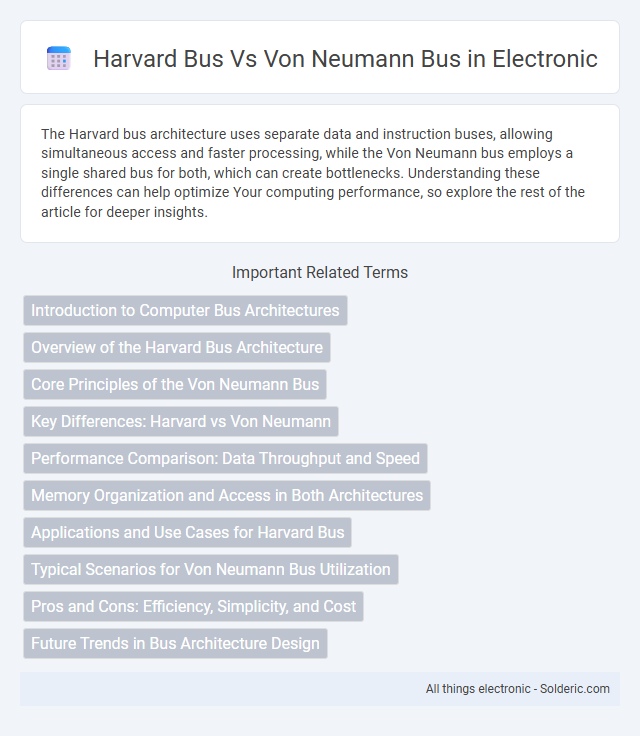The Harvard bus architecture uses separate data and instruction buses, allowing simultaneous access and faster processing, while the Von Neumann bus employs a single shared bus for both, which can create bottlenecks. Understanding these differences can help optimize Your computing performance, so explore the rest of the article for deeper insights.
Comparison Table
| Feature | Harvard Bus | Von Neumann Bus |
|---|---|---|
| Bus Architecture | Separate buses for data and instructions | Single unified bus for data and instructions |
| Memory Organization | Separate memory for instructions and data | Shared memory for both data and instructions |
| Data Transfer | Simultaneous access to instructions and data; faster | Sequential access; slower due to bus contention |
| Complexity | More complex bus design; higher cost | Simpler design; cost-effective |
| Typical Use Cases | Microcontrollers, DSPs, embedded systems | General-purpose CPUs, desktops, servers |
| Performance | Higher performance with parallel access | Lower performance due to shared bus bottleneck |
| Flexibility | Less flexible; fixed instruction and data paths | More flexible; supports dynamic instruction/data use |
Introduction to Computer Bus Architectures
The Harvard bus architecture separates data and instruction buses, allowing simultaneous access to memory locations and improving processing speed in embedded systems and digital signal processors. In contrast, the Von Neumann bus architecture uses a single bus for both data and instructions, which can cause bottlenecks as instruction fetch and data access compete for the same bus. Understanding these differences helps you design efficient computer systems tailored to specific performance and application needs.
Overview of the Harvard Bus Architecture
The Harvard bus architecture features separate memory buses for instruction and data storage, enabling simultaneous access and faster processing speeds compared to the Von Neumann bus architecture, which uses a single bus for both. This separation reduces bottlenecks by allowing parallel data and instruction fetches, enhancing overall system efficiency in embedded and real-time computing. Your choice of architecture can significantly impact processing performance depending on the specific application requirements.
Core Principles of the Von Neumann Bus
The Von Neumann bus operates on a single shared data path for both instructions and data, enabling a sequential fetch-execute cycle that simplifies control logic. This architecture uses a unified memory system where program instructions and data reside together, leading to potential bottlenecks known as the "Von Neumann bottleneck." Core principles of the Von Neumann bus emphasize time-multiplexed access to memory and the central processing unit, allowing a streamlined but sequential data transfer process.
Key Differences: Harvard vs Von Neumann
The Harvard bus architecture uses separate memory buses for data and instructions, enabling simultaneous access and increasing processing speed. In contrast, the Von Neumann bus architecture employs a single shared bus for both data and instructions, which can cause a bottleneck known as the Von Neumann bottleneck. Harvard architecture is typically used in digital signal processors and microcontrollers for faster execution, while Von Neumann architecture is common in general-purpose computers due to its simpler design.
Performance Comparison: Data Throughput and Speed
The Harvard bus architecture separates data and instruction pathways, enabling simultaneous access that significantly boosts data throughput and speed compared to the Von Neumann bus, which uses a single shared bus for both instructions and data. This separation reduces bottlenecks and enhances parallelism, resulting in faster execution times for programs that require high-speed data processing. Understanding your system's data handling needs will help determine whether Harvard's superior throughput or Von Neumann's simpler design best suits your application.
Memory Organization and Access in Both Architectures
Harvard bus architecture features separate memory spaces and buses for instructions and data, enabling simultaneous access and improved throughput by allowing parallel fetches. Von Neumann bus architecture uses a unified memory system and a single bus for both instructions and data, which can cause bottlenecks due to sequential access. The distinct separation in Harvard architecture optimizes memory bandwidth and reduces latency compared to the shared pathway in Von Neumann systems.
Applications and Use Cases for Harvard Bus
Harvard bus architecture is widely applied in digital signal processors (DSPs), microcontrollers, and embedded systems where fast and efficient data processing is critical, such as in real-time audio and video processing, robotics, and telecommunications. Its separate memory pathways for instructions and data enable simultaneous access, enhancing performance in applications requiring high-speed computation and low latency. You benefit from the Harvard bus architecture when designing systems that prioritize speed and efficiency in executing parallel instruction and data operations.
Typical Scenarios for Von Neumann Bus Utilization
Von Neumann bus architecture is commonly utilized in general-purpose computing systems where simplicity and flexibility in program storage are prioritized, such as in personal computers and embedded systems. Its shared data and instruction bus configuration suits applications requiring sequential instruction execution and dynamic memory allocation. Your systems benefit from this model when running diverse software demanding uniform access to memory for both instructions and data.
Pros and Cons: Efficiency, Simplicity, and Cost
The Harvard bus architecture offers higher efficiency by allowing simultaneous access to instruction and data memory, which speeds up processing but increases hardware complexity and cost due to separate memory buses. The Von Neumann bus design is simpler and more cost-effective since it uses a single shared bus for instructions and data but suffers from slower performance caused by bottlenecks during memory access. Your choice between these architectures depends on whether you prioritize processing speed and efficiency or simplicity and budget constraints.
Future Trends in Bus Architecture Design
Future trends in bus architecture design highlight the growing adoption of Harvard bus due to its separate instruction and data pathways, which enhance parallelism and reduce bottlenecks in high-performance computing. Innovations focus on increasing bandwidth and minimizing latency by integrating advanced cache hierarchies and employing heterogeneous bus systems. Emerging architectures leverage the Harvard bus model to support AI accelerators and real-time processing, whereas Von Neumann buses face limitations in throughput and scalability under modern multitasking demands.
Harvard bus vs Von Neumann bus Infographic

 solderic.com
solderic.com